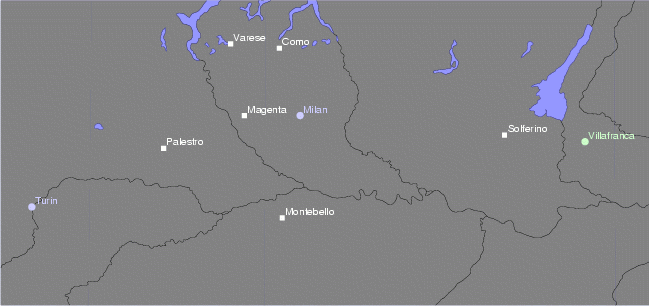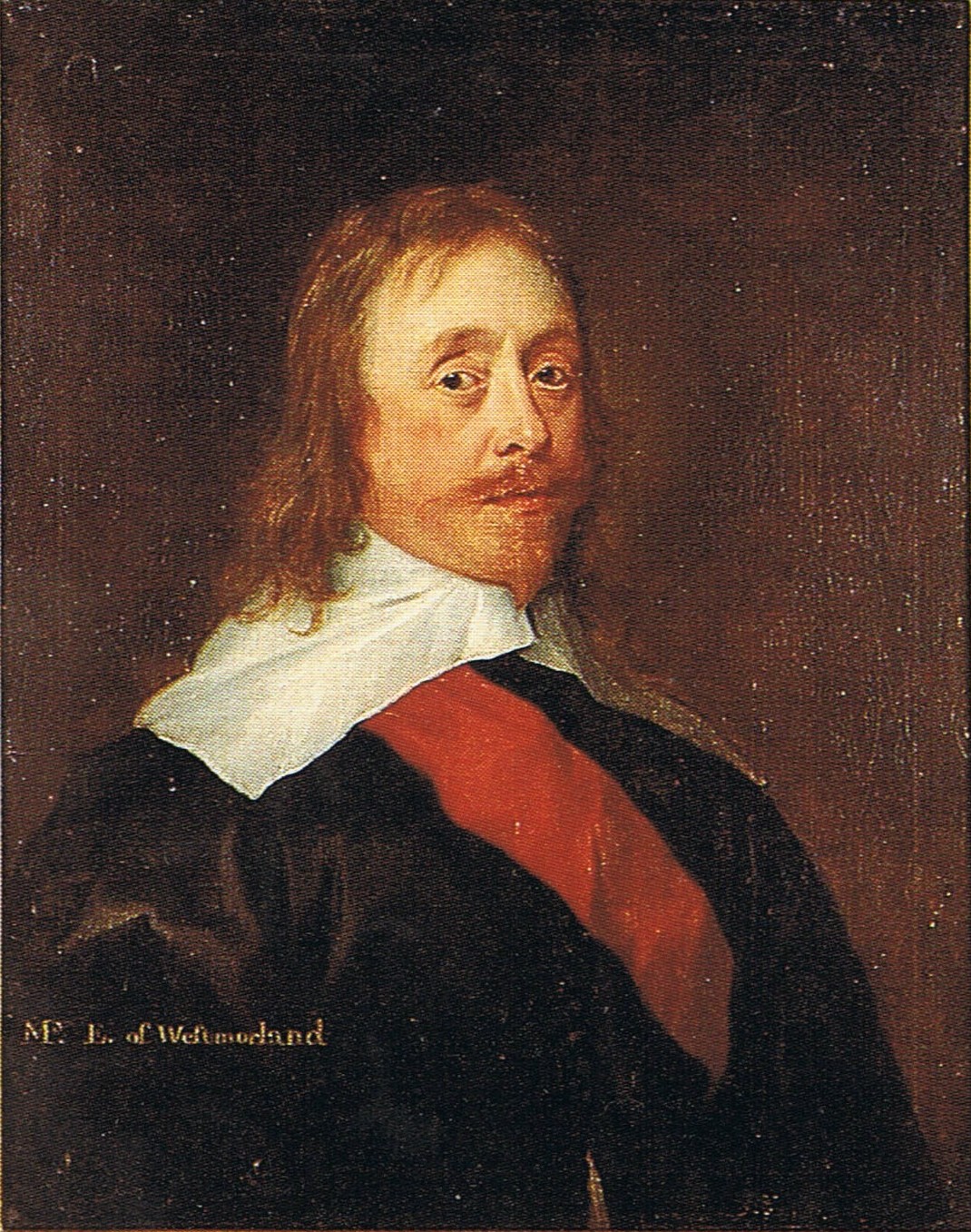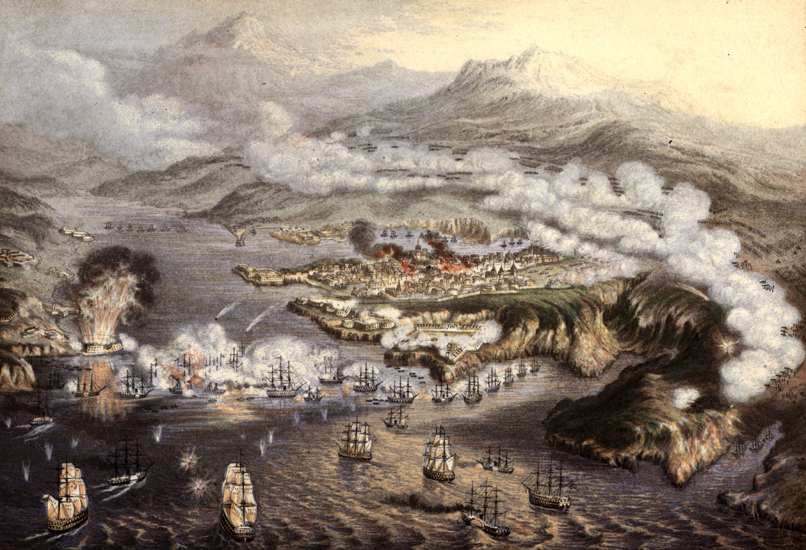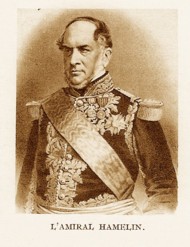|
Ădouard BouĂŤt-Willaumez
Louis Ădouard BouĂŤt-Willaumez (24 April 1808 â 9 September 1871) was a French admiral. Biography Louis Ădouard BouĂŤt was the son of a businessman (and mayor of LambĂŠzellec), born in Maisons-Laffitte, near Paris. Having joined the French Navy in 1824 he embarked on a five-year voyage, first in the Mediterranean (where he saw action at the Battle of Navarino in 1827) and then in the Indian Ocean. In 1829 he was promoted to ship's ensign and served in the Morea expedition. In 1830 he was part of the blockade and capture of Algiers, followed by the blockade of Antwerp. Made Lieutenant in 1834, he was attached to the naval post at La Plata, from where he was sent to Senegal. In 1836 he took command of the steamship ''L'Africain'', with which he travelled 200 miles inland, up to the FĂŠlou Falls (''les Chutes de FĂŠlou'') in upper Senegal. He was the only Westerner to return alive, the others having succumbed to disease. In 1838 BouĂŤt took command of the brig ''La Malouine'' ... [...More Info...] [...Related Items...] OR: [Wikipedia] [Google] [Baidu] |
Bundu, Senegal
Bundu (also Bondu, Bondou and Boundou) was a state in West Africa existing from the late 17th century until it became a French protectorate dependent on the colony of Senegal. It lay between the FalÊmÊ River and the upper course of the Gambia River, that is between 13 and 15 N., and 12 and 13 W. Description The country is an elevated plateau, with hills in the southern and central parts. These are generally unproductive, and covered with stunted wood; but the lower country is fertile, and finely clothed with the baobab, the tamarind and various valuable fruit-trees. Bondu is traversed by torrents, which flow rapidly during the rains but are empty in the dry season. This cites A. Rançon, ''Le Bondou: Êtude de gÊographie et d'histoire soudaniennes de 1681 à nos jours'' (Bordeaux, 1894). The name 'Bundu' means 'well' in Pulaar. History Early History Bundu in the 17th century was a sparsely populated part of the kingdom of Gajaaga inhabited mostly by Pulaar communities but ... [...More Info...] [...Related Items...] OR: [Wikipedia] [Google] [Baidu] |
Second Italian War Of Independence
The Second Italian War of Independence, also called the Sardinian War, the Austro-Sardinian War, the Franco-Austrian War, or the Italian War of 1859 (Italian: ''Seconda guerra d'indipendenza italiana''; German: ''Sardinischer Krieg''; French: ''Campagne d'Italie''), was fought by the Second French Empire and the Kingdom of Sardinia (1720â1861), Kingdom of Sardinia against the Austrian Empire in 1859 and played a crucial part in the process of Italian Unification. A year prior to the war, in the Plombières Agreement, France agreed to support Sardinia's efforts to expel Austria from Italy in return for territorial compensation in the form of the Duchy of Savoy and the County of Nice. The two states signed a military alliance in January 1859. Sardinia mobilised its army on 9 March 1859, and Austria mobilized on 9 April. On 23 April, Austria delivered an ultimatum to Sardinia demanding its demobilization. Upon Sardinia's refusal, the war began on 26 April. Austria invaded Sardin ... [...More Info...] [...Related Items...] OR: [Wikipedia] [Google] [Baidu] |
Order Of The Bath
The Most Honourable Order of the Bath is a British order of chivalry founded by King George I of Great Britain, George I on 18 May 1725. Recipients of the Order are usually senior British Armed Forces, military officers or senior Civil Service (United Kingdom), civil servants, and the monarch awards it on the advice of His Majesty's Government. The name derives from an elaborate medieval ceremony for preparing a candidate to receive his knighthood, of which ritual bathing (as a symbol of Ritual purification, purification) was an element. While not all knights went through such an elaborate ceremony, knights so created were known as "knights of the Bath". George I constituted the Knights of the Bath as a regular Order (honour), military order. He did not revive the order, which did not previously exist, in the sense of a body of knights governed by a set of statutes and whose numbers were replenished when vacancies occurred. The Order consists of the Sovereign of the United King ... [...More Info...] [...Related Items...] OR: [Wikipedia] [Google] [Baidu] |
Siege Of Sevastopol (1854â1855)
The siege of Sevastopol (at the time called in English the siege of Sebastopol) lasted from October 1854 until September 1855, during the Crimean War. The allies ( French, Sardinian, Ottoman, and British) landed at Eupatoria on 14 September 1854, intending to make a triumphal march to Sevastopol, the capital of the Crimea, with 50,000 men. Major battles along the way were Alma (September 1854), Balaklava (October 1854), Inkerman (November 1854), Tchernaya (August 1855), Redan (September 1855), and, finally, Malakoff (September 1855). During the siege, the allied navy undertook six bombardments of the capital, on 17 October 1854; and on 9 April, 6 June, 17 June, 17 August, and 5 September 1855. The siege of Sevastopol is one of the last classic sieges in history. The city of Sevastopol was the home of the tsar's Black Sea Fleet, which threatened the Mediterranean. The Russian field army withdrew before the allies could encircle it. The siege was the culminating struggle for ... [...More Info...] [...Related Items...] OR: [Wikipedia] [Google] [Baidu] |
Bombardment Of Odessa
The Bombardment of Odessa was an action during the Crimean War in which a joint Anglo-French squadron of warships attacked the Russian port of Odessa. Background and formation On 6 April 1854, soon after the declaration of war by Britain and France on Russia, the British steam frigate , under the command of Captain William Loring, sailed to Odessa and sent a boat into the port under a flag of truce to collect the British Consul there. When leaving the port the boat was fired upon by the Russians. The British naval commander Vice-Admiral James Dundas demanded an explanation from Lieutenant-General Dmitri Osten-Sacken, the military governor of Odessa, for this breach of the laws of war. His reply was considered unacceptable, so a squadron was quickly selected to mount a punitive expedition. An article by Karl Marx, printed in the '' New York Daily Tribune'' of 16 May 1854, reported that the Russians had claimed that the ''Furious'' was actually carrying out a covert reconnai ... [...More Info...] [...Related Items...] OR: [Wikipedia] [Google] [Baidu] |
Crimean War
The Crimean War was fought between the Russian Empire and an alliance of the Ottoman Empire, the Second French Empire, the United Kingdom of Great Britain and Ireland, and the Kingdom of Sardinia (1720â1861), Kingdom of Sardinia-Piedmont from October 1853 to February 1856. Geopolitical causes of the war included the "Eastern question" (Decline and modernization of the Ottoman Empire, the decline of the Ottoman Empire, the "sick man of Europe"), expansion of Imperial Russia in the preceding Russo-Turkish wars, and the British and French preference to preserve the Ottoman Empire to maintain the European balance of power, balance of power in the Concert of Europe. The flashpoint was a dispute between France and Russia over the rights of Catholic Church, Catholic and Eastern Orthodox Church, Orthodox minorities in Palestine (region), Palestine. After the Sublime Porte refused Nicholas I of Russia, Tsar Nicholas I's demand that the Empire's Orthodox subjects were to be placed unde ... [...More Info...] [...Related Items...] OR: [Wikipedia] [Google] [Baidu] |
François Alphonse Hamelin
Ferdinand-Alphonse Hamelin (2 September 1796 â 10 January 1864), French admiral, was born in Pont-l'ĂvĂŞque, Normandy. He was the nephew of Jacques FĂŠlix Emmanuel Hamelin, a successful rear admiral in the French Navy of the Napoleonic era. Early career Hamelain went to sea in 1806 as cabin boy with his uncle, Jacques FĂŠlix Emmanuel Hamelin, on the frigate '' VĂŠnus'' in the era of Napoleon and the French Empire. The ''VĂŠnus'' was part of the French squadron in the Indian Ocean during the Mauritius Campaign of 1809-1811, and young Hamelin had an opportunity of seeing much active service. She, in company with another and a smaller vessel, captured the English frigate ''Ceylon'' in 1810, but was immediately afterwards captured herself by the '' Boadicea'', under Commodore Josias Rowley (1765â1842). Young Hamelin was a prisoner of war for a short time. His identification as François seems to be in error. Career after the First French Empire fell He returned to Franc ... [...More Info...] [...Related Items...] OR: [Wikipedia] [Google] [Baidu] |
Rear Admiral
Rear admiral is a flag officer rank used by English-speaking navies. In most European navies, the equivalent rank is called counter admiral. Rear admiral is usually immediately senior to commodore and immediately below vice admiral. It is usually equivalent to the rank of major general in armies. In the U.S. Navy and some other navies, there are two rear admiral ranks. The term originated in the days of naval sailing squadrons and can trace its origins to the British Royal Navy. Each naval squadron was assigned an admiral as its head, who commanded from the centre vessel and directed the squadron's activities. The admiral would in turn be assisted by a vice admiral, who commanded the lead ships that bore the brunt of a battle. In the rear of the squadron, a third admiral commanded the remaining ships and, as this section was considered to be in the least danger, the admiral in command of it was typically the most junior. This has continued into the modern age, with rear ... [...More Info...] [...Related Items...] OR: [Wikipedia] [Google] [Baidu] |
Bayonet
A bayonet (from Old French , now spelt ) is a -4; we might wonder whether there's a point at which it's appropriate to talk of the beginnings of French, that is, when it wa ... , now spelt ) is a knife, dagger">knife">-4; we might wonder whether there's a point at which it's appropriate to talk of the beginnings of French, that is, when it wa ... , now spelt ) is a knife, dagger, sword, or Spike bayonet, spike-shaped melee weapon designed to be mounted on the end of the gun barrel, barrel of a rifle, carbine, musket or similar long gun, long firearm, allowing the gun to be used as an improvised spear in close combat.Brayley, Martin, ''Bayonets: An Illustrated History'', Iola, WI: Krause Publications, (2004), pp. 9â10, 83â85. The term is derived from the town of Bayonne in southwestern France, where bayonets were supposedly first used by Basques in the 17th century. From the early 17th to the early 20th century, it was an infantry melee weapon used for both offensive and ... [...More Info...] [...Related Items...] OR: [Wikipedia] [Google] [Baidu] |
LĂŠgion D'honneur
The National Order of the Legion of Honour ( ), formerly the Imperial Order of the Legion of Honour (), is the highest and most prestigious French national order of merit, both military and Civil society, civil. Currently consisting of five classes, it was originally established in 1802 by Napoleon, Napoleon Bonaparte, and it has been retained (with occasional slight alterations) by all later French governments and regimes. The order's motto is ' ("Honour and Fatherland"); its Seat (legal entity), seat is the Palais de la LÊgion d'Honneur next to the MusÊe d'Orsay, on the left bank of the Seine in Paris. Since 1 February 2023, the Order's grand chancellor has been retired General François Lecointre, who succeeded fellow retired General BenoÎt Puga in office. The order is divided into five degrees of increasing distinction: ' (Knight), ' (Officer), ' (Commander (order), Commander), ' (Grand Officer) and ' (Grand Cross). History Consulate During the French Revolution, all ... [...More Info...] [...Related Items...] OR: [Wikipedia] [Google] [Baidu] |




